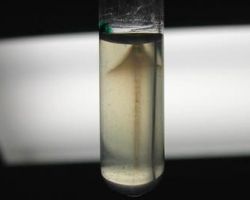SEARCH
Search
Motility_Listeria monocytogenes_semi solid media
-
General
Motility testing Listeria monocytogenes
motile à 28oC 1-5 peritrichous flagella
less to no motile à 37oC
This bacterium exhibits characteristic tumbling motility when viewed with light microscopy
Though L. monocytogenes is actively motile by means of peritrichous flagella at room temperature (20−25 °C), the organism does not synthesize flagella at body temperatures (37 °C)
The semi-solid motility agar containing 0.2-0.4% agar is stabbed (about 1 cm).
At 20-28°C, Listeriae inoculated into the agar column swarm through the ‘motility medium’ and produce cloudiness.
This can easily be observed by the naked eye.
About 0.5 cm below the surface of the agar a layer of increased growth is found, like an umbrella. In this zone of reduced oxygen tension Listeria shows a better development than under aerobic or strictly anaerobic conditions.
SEE WEBSITE: Listeria monocytogenes
-
History
L. monocytogenes was first described by E.G.D. Murray in 1924 based on six cases of sudden death in young rabbits, and published a description with his colleagues in 1926 .
Murray referred to the organism as Bacterium monocytogenes before Harvey Pirie changed the genus name to Listeria in 1940.
Although clinical descriptions of L. monocytogenes infection in both animals and humans were published in the 1920s, it was not recognized as a significant causeof neonatal infection, sepsis, and meningitis until 1952 in East Germany.
Listeriosis in adults was later associated with patients living with compromised immune systems, such as individuals taking immunosuppresant drugs and corticosteroids for malignancies or organ transplants, and those with HIV infection.L. monocytogenes was not identified as a cause of foodborne illness until 1981, however. An outbreak of listeriosis in Halifax, Nova Scotia, involving 41 cases and 18 deaths, mostly in pregnant women and neonates, was epidemiologically linked to the consumption of coleslaw containing cabbage that had been contaminated with L. monocytogenes-contaminated sheep manure. Since then, a number of cases of foodborne listeriosis have been reported, and L. monocytogenes is now widely recognized as an important hazard in the food industry.
-
Related
-
References
wikipedia
Photo
MMIZ_ErasmusMC,
Rotterdam
https://twitter.com/pathologyuams/status/496644729812295681

-250x200.jpg)

